#cleve Francis
Explore tagged Tumblr posts
Text








Black Country Singers
Charlie Pride 1934-2020
Linda Martell 1941- living
Darius Rucker 1966-living
Lesley Riddle 1905-1980
Deford Bailey 1899-1982
Cleve Francis 1945 -living
The Pointer Sisters 1969
Frankie Staton -living
Rest In Peace June Pointer, Anita Pointer, Bonnie Pointer
Country Music Is BLACK CULTURE
HAPPY BLACK HISTORY MONTH
#black girl aesthetic#black culture#happy black history#black history month#country music is black culture#black country singers#linda martell#deford bailey#the pointer sisters#darius rucker#frankie staton#lesley riddle#cleve Francis#black people are the blueprint#black power#black and proud#we are history#legends#black is better#black excellence#our culture#black girl blogger#black girls of tumblr#black girl magic#country album of the year#country girls#country boy#southern culture#black black black#we the people
449 notes
·
View notes
Text










Six The Musical as Tweets pt63
#six the musical#six#catherine of aragon#catherine parr#anne boleyn#anna von kleve#anna of cleves#anne of cleves#mary i#mary i of england#maud on the rhythm guitar#maud lane#maud parr#elizabeth blount#bessie Blount#bessie on the bass#mary tudor#juana la loca#juana de Aragón#joanna of Aragon#francis of lorraine#francis i duke of lorraine#François Ier de Lorraine#six the twitter#six the musical twitter#six twitter#Twitter#tweets
22 notes
·
View notes
Text

Portrait of Francis I, King of France
Artist: Joos van Cleve (Dutch, c. 1485–1540/41)
Date: c. 1532-1533
Medium: Oil on panel
Collection: Philadelphia Museum of Art, Philadelphia, PA, United States of America
Description
Francis I possibly commissioned this portrait in connection with his second marriage, to Eleanor of Austria, or in commemoration of a meeting with King Henry VIII of England. During his long reign (1515-1547) Francis established France as a center of the arts and attracted many famous artists to his court, including Leonardo da Vinci, whose last years were spent there.
#portrait#painting#francis i#king of france#16th century painting#european#joos van cleve#dutch painter#oil on panel#philadelphia museum of art#francis i of france#french empire#french history#french monarchy#costume#hat#historical portrait#dutch culture#dutch art#european art
9 notes
·
View notes
Text
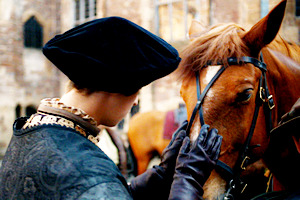
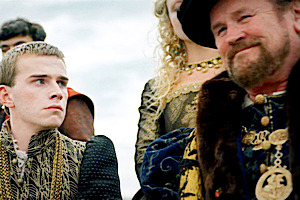


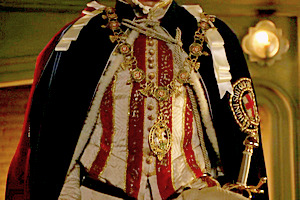
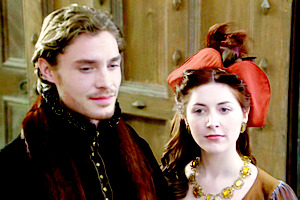

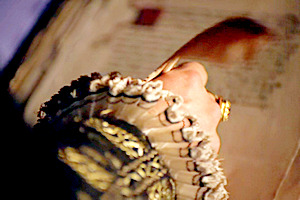
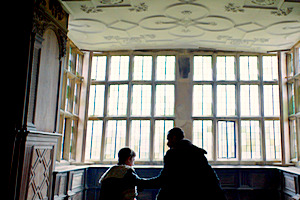
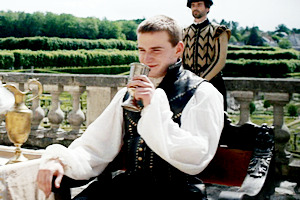
♕ @dailytudors TUDOR WEEK 2024 ♕
Day Three: Best Tudor What If >> 2/2 - HENRY FITZROY LIVES
Henry, Duke of Richmond, the beloved first son of Henry VIII born out of wedlock survives his sickness of 1536. Henry was made a possible heir to his father by the 1536 Successions Act until the birth of a child by his third stepmother Jane Seymour who had recently married his father.
During this time Fitzroy consummates his marriage with his wife Mary the daughter of the Duke of Norfolk. They later had four children, three sons one named after himself and his beloved father, one after St. George and one after his wife's father Thomas, and, a daughter named after his wife and beloved sister Mary, the latter stood as godmother to the younger Mary.
In 1537, his beloved brother, the future Edward VI is born, however Fitzroy's stepmother Jane only survives the birth by a few days. During the official mourning period Fitzroy provides a strong support to his father during his grief and emerges in court as one of the possible leading figures.
Henry then lived through his father marrying another two women, one ending in divorce and the other in execution, the latter being the cousin of his wife, but, during the time of this marriage, Fitzroy was abroad as he was the ambassador to France as he had been educated in the court of Francis I and was close friends with the Dauphin.
Once recalled from France after his father's disastrous fifth marriage he became a prominent figure in court after many leading courtiers left places vacant after being executed by his father (the gaping hole Thomas Cromwell left was widely felt even by his enemies). In this time he starts to take part in the council and education of his brother Edward with his father and appoints a few of his tutors.
In 1543 he was in attendance for his father's last marriage to Catherine Parr who is only six years his senior and was the sister of his close friend Thomas. During this time not only does Catherine bring his youngest sister Elizabeth back into the fold she also further nurtures Henry VIII's relationship with all his children and now grandchildren. Mary Fitzroy, Duchess of Richmond becomes a close confidant and part of the Queen's inner circle and the fourth lady of the court after her step-mother-in-law and sisters-in-law and even outranking the ex-Queen Anne of Cleves now known as the Kings Sister solidifying Henry Fitzroy as a possible heir after his own brother, debatably in front of his sisters.
During 1544 Henry accompanied his father on a campaign which later became known Battle of Boulogne where he learnt warfare and matters of the military.
In 1547 his beloved and larger-than-life father died, leaving his brother Edward VI a young King in his minority. Richmond's careful years of tutelage in the ever-changing court of his father proved to be a well-earned place in the council of his brother while he provided a much-needed balance between his brother's maternal family the Seymours, the rising faction of the protestants and the well-known conservative faction which included his sister Mary. During this time Henry became the leading figure of court and council and the well-accepted heir of his brother as he was the senior male.
Henry having strong links to France secured an advantageous marriage for his brother to Princess Elizabeth of France the daughter of his longtime friend which proved fruitful. It is debated that during the earlier days of his reign after his minority - before Queen Elizabeth had sons - Edward considered bestowing the title of the Duke of York on his brother.
Henry oversaw the marriages of his sons to daughters of the Seymour, Howard and Grey families and the marriage of his much-loved daughter Mary - who is said to be his favourite child - off to a son of John Dudley (Mary then ended up being a sister-in-law in marriage to her Tudor Aunt Elizabeth who had married one of John's other sons Robert).
Henry died strong in his position as the most prominent man at court after his brother, the King, having seen through and guided him in his minority. He was survived by his wife and four children.
#tudorweek2024#perioddramaedit#the tudors#becoming elizabeth#henry fitzroy#mary howard#henry viii#edward vi#my edits
71 notes
·
View notes
Text
Mary Tudor and Katherine Howard could have actually been friends? 🏵️
All of us Tudor fans have been persuaded at some point to believe that Mary and Katherine were enemies and couldn't stand each other. If we were to read separate biographies of katherine and Mary, we would indeed get that impression, especially when it comes to the narratives of certain authors who didn't see much need to delve into the relationship between the two.
🧐 What do we know about Mary and Katherine's relationship besides common belief? That Katherine wanted to dismiss two of Mary's ladies because Katherine was a spoiled and childish young lady, or that Mary found Katherine vain because she liked to dress francy clothes and dance. But what if I told you that Katherine acted as a merciful queen in many instances, such as when she sent her tailor to Margaret Pole in the Tower of London or when she helped free Thomas Wyatt, the poet, from the Tower? And what about Mary liking fancy clothes and dance too? But well, we will not try to understand Katherine's qualities hidden in the shadow of the stereotype this time. In order not to develop a giant text, I will just make a timeline of the relationship between the two from 1540 to 1542.
🏵️1540 — DECEMBER — Katherine try to dismiss two of Mary's ladies because Mary was showing her little respect as she had shown Jane Seymour and Anne of Cleves. (In my opinion, this only happened because Mary was witnessing what happened to her mother repeat itself. *Let's not forget that Katherine was a lady-in-waiting to Anne of Cleves, as Anne Boleyn was to Katherine of Aragon*).
🏵️ 1541 — JANUARY — (New Year) Mary tries to reconcile with Katherine and sends gifts, trying to maintain a good relationship with her father and stepmother.
🏵️ 1541 — 2 of FEBRUARY — Henry banishes one of Mary's ladies. Chapuys was the one who reported this, and unlike the first occasion when Katherine tried to dismiss two of Mary's ladies, on this occasion Chapuys mentions only the king. I believe that if it had been an appeal from Katherine to the king, Chapuys would have mentioned it, as before.
(It would not be the first time Henry had expelled ladies-in-waiting. He did the same to Katherine of Aragon when the two argued over the attention the king was giving to Henry Fitzroy. That time he expelled three of Katherine's ladies-in-waiting).
🏵️ 1541— 22 of FEBRUARY — Mary and Katherine baptise Jane Seymour daughter of Edward Seymour (Edward VI uncle). Why did they both were godparent of the same child if they were not in good terms? This makes me believe that Mary's problem 20 days before this was indeed with the king.
🏵️ 1541 — Spring — Katherine is said to have sent Margaret Pole clothes according to Alison Weir, she didn't mention an exact month, but Conor Byrne points to 'spring' (so, March, April or early May). I know Katherine had a good heart and Margaret's situation touched her, but I think she may have had some consideration for Mary when she did this.
🏵️ 1541 — MAY — Margaret Pole is executed, the same time Katherine aproves Mary staying at court. (This is why I believe she had some regard for Mary's pain of losing her second mother.)
🏵️ 1541 — In the summer Katherine, Mary and Henry traveled together to visit Prince Edward, and Katherine gave Mary a gold pomander containing a clock while they were on a progress at Pontefract Castle. (Again, why would she if they were not in good terms?)
🏵️ 1542 — FEBRUARY — Katherine is executed. "Following Katherine Howard’s execution, Mary enjoyed far greater favour and presided over court feasts as if Queen. As a New Year’s gift Henry presented her ‘with rings, silver plate, and other jewels’ among which were ‘two rubies of inestimable value’. However, during these months, the princess suffered repeatedly from chronic ill-health, linked to anxiety, depression and irregular menstruation, although the symptoms varied widely from one episode to the next. In March and April, she had a ‘strange fever’ that brought on heart palpitations and so afflicted her that at times ‘she remained as though dead’."
-
We know that Katherine died in February, but by December Culpeper had been executed, and the queen's jewels had certainly returned to the king who had given them to Mary. If Mary had developed any feelings of friendship with Katherine, it was very cruel of him to make her go through this, and I am not surprised that Mary fell strangely ill afterwards. 😪💔
-
Art by: https://www.instagram.com/heqijin_illustration?igsh=MTRjZTN4bzJqcXJseA==
-
Sources:
https://tudortreasures.net/mary-catherine-howard/
https://en.m.wikipedia.org/wiki/Jewels_of_Mary_I_of_England
Katherine Howard: A New History by Conor Byrne.
Mary Tudor: England' First Queen by Anna Whitelock.
Baatard Prince: Henry VIII'S lost son by Beverley A. Murphy.








13 notes
·
View notes
Text
Kingdoms and Empires by Jaclyn Moriarty (2017-2023)
Bronte Mettlestone's parents ran away to have adventures when she was a baby, leaving her to be raised by her Aunt Isabelle and the Butler. She's had a perfectly pleasant childhood of afternoon teas and riding lessons - and no adventures, thank you very much.
But Bronte's parents have left extremely detailed (and bossy) instructions for Bronte in their will. The instructions must be followed to the letter, or disaster will befall Bronte's home. She is to travel the kingdoms and empires, perfectly alone, delivering special gifts to her ten other aunts. There is a farmer aunt who owns an orange orchard and a veterinarian aunt who specialises in dragon care, a pair of aunts who captain a cruise ship together and a former rockstar aunt who is now the reigning monarch of a small kingdom.
Now, armed with only her parents' instructions, a chest full of strange gifts and her own strong will, Bronte must journey forth to face dragons, Chief Detectives and pirates - and the gathering suspicion that there might be something more to her extremely inconvenient quest than meets the eye...
The Lost Conspiracy by Francis Hardinge (2008)
On Gullstruck Island, legend has it that the mountain ranges and volcanoes are in charge. Anger them, and you'll pay the price. Keep them happy, and you'll enjoy their protection. These stories of the land's command come in handy for quiet, near-invisible Hathin when she must run for her life. Hathin's sister, Arilou, is believed to be a Lost. The Lost are held nearly sacred by those on Gullstruck, for they can send their senses away from their bodies. If Lost, Arilou can read a message across the island. If Lost, Arilou can hear whispers in the corners of private rooms. If Lost, Arilou can smell bread baking in the governor's mansion. All from her beachside hut. But the question remains: Is Arilou really a Lost? When all the Lost drop dead--except Arilou--she and Hathin are swept into a grand conspiracy that leads them to the most sinister depths--and heights--of the island.
Isola by Brenden Fletcher (2018-2020)
An evil spell has been cast on the Queen of Maar and her Captain of the Guard will do anything to reverse it. Their only hope lies on an island half a world away--a place known in myth as Isola, land of the dead.
The Secret of a Heart Note by Stacey Lee (2016)
Sometimes love is right under your nose. As one of only two aromateurs left on the planet, sixteen-year-old Mimosa knows what her future holds: a lifetime of weeding, mixing love elixirs, and matchmaking—all while remaining incurably alone. For Mim, the rules are clear: falling in love would render her nose useless, taking away her one great talent. Still, Mimosa doesn’t want to spend her life elbow-deep in soil and begonias. She dreams of a normal high school experience with friends, sports practices, debate club, and even a boyfriend. But when she accidentally gives an elixir to the wrong woman and has to rely on the lovesick woman’s son, the school soccer star, to help fix the situation, Mim quickly begins to realize that falling in love isn’t always a choice you can make.
The Fairy Realm by Emily Rodda (2001-2006)
When Jessie searches for her ill grandmother's missing charm bracelet, she is led to a magical world and finds she has a reason and right to be there.
Lays of the Hearth-Fire by Victoria Goddard (2019-2023)
Cliopher Mdang knows all about consequences. He is the Secretary in Chief of the offices of the Lords of State: the official head of the Imperial Bureaucratic Service of Zunidh, unofficial head of the government. He spends his days dealing with all the manifold results of enormously complicated systems.
He is also the personal secretary to his Radiency Artorin Damara, Last Emperor of Astandalas, Lord of Zunidh: the Sun-on-Earth, the Lord of Tising Stars, worshiped as a god.
Cliopher has never touched his lord, never called him by name, never initiated a conversation. He would never say aloud that he loves him, but it is for his lord, and not his own power or prestige, that he spends his life far from home and the family who have never quite forgiven him for leaving.
It is blasphemy to suggest that the Sun-on-Earth might need something as ordinary in human as a break. But one day Cliopher turns to his lord and invites him on a holiday to his homeland, the tropical paradise of Vangavaye-ve, which is as far from the court as it is possible to be. It is a place where pretension is soundly discouraged and pretenses are undone, and where the divine never very far from the human.
Valkyrie by Kate O'Hearn (2013-2016)
Freya is dreading her upcoming birthday when she'll officially have to take up her duties as a Valkyrie. She doesn't want to follow in the footsteps of the legends before her--legends including her mother and sisters. And she certainly doesn't want anything to do with humans
Freya thinks humans are cruel, hate-filled creatures, but as she observes their world, she begins to wonder what it would be like to make friends with the girls or laugh with the boys she sees. And what would it be like to live without the fear that she could cause someone's death with a single touch?
Then when she's sent on her first mission, she reaps the soul of a fallen soldier with unfinished business...business that sends her on an epic quest to the mortal world. Will Freya find the true meaning of being a human, or will she finally accept the legend she is destined to become?
Doomspell by Cliff McNish (2000-2002)
In a blaze of light, rush of wind and scrabble of claws, Rachel and Eric are ripped through the wall and hurtled on to another world. Like thousands of other children before them, they have been snatched away by the Witch.
But this time the Witch has met her match. Rachel discovers that she has extraordinary gifts: she can transform herself into a feather, or fly on an owl’s back, just as the Witch can. The Witch is excited she has found someone to use for her own evil purposes. But for the Witch’s victims, Rachel is their only hope.
Drizzle by Kathleen Van Cleve (2010)
Eleven-year-old Polly Peabody knows her family's world-famous rhubarb farm is magical. The plants taste like chocolate, jewels appear in the soil, bugs talk to her, and her best friend is a rhubarb plant named Harry. But the most magical thing is that every single Monday, at exactly 1:00, it rains. Until the Monday when the rain just stops. Now it's up to Polly to figure out why, and whether her brother's mysterious illness and her glamorous aunt Edith's sudden desire to sell the farm have anything to do with it. Most of all, Polly has to make it start raining again before it's too late. Her brother's life, the plants' survival, and her family's future all depend on it.
Lyra by Patricia C. Wrede (1982-1994)
Trouble is brewing in Alkyra. While the kingdom’s noblemen squabble, on their borders an ancient enemy, the Lithmern, raises an army. As the head of the Noble House of Brenn attempts to organize an alliance, the princess Alethia celebrates her twentieth birthday. She is a remarkable woman: quick-witted, beautiful, and handy with a throwing knife. But on the next night, she passes through a dark corridor on her way to the banquet hall, and never emerges from the shadows. The Lithmern have kidnapped the princess. When Alethia regains consciousness, an evil Lithmern with a face made of shadows is carrying her through the forest. These are magic woods, home to fabled creatures whose existence she has always doubted. To find her way home, Alethia will have to learn to trust in the old tales, whose legends of magic and daring hold the only hope of saving her kingdom.
#best fantasy book#poll#kingdoms and empires#the lost conspiracy#isola#the secret of a heart note#the fairy realm#lays of the hearth fire#valkyrie#drizzle#lyra#doomspell
22 notes
·
View notes
Text









• The ISTJ personality type is common (13%), known for integrity, practical logic, and a strong sense of duty. ISTJs are reliable, dedicated, and thrive in environments with clear rules and structure, such as the military or government. They are practical and fact-oriented, preferring to verify information and make realistic plans.
• ISTJs value autonomy and are frustrated by indecision or inefficiency, expecting others to act quickly on their decisions. They are self-sufficient, prefer working alone or in structured settings, and are committed to following through on their obligations. While they may seem cold, they are deeply hurt by suggestions they lack feelings.
• Though their reliability is a strength, ISTJs risk being overburdened by others. It’s important for them to take care of themselves to avoid burnouts, long term stress and depression. When appreciated for their dedication, ISTJs find satisfaction in being part of a well-functioning system.
Strengths: honest and direct, disciplined, very responsible, calm and practical, organised and effective, research oriented.
Weaknesses: stubborn, insensitive, always by the book, judgmental, prone to burnout.
ISTJ characters: Hermione Granger (Harry Potter book), Tigress (Kung Fu Panda), Ned Stark (Game of Thrones), Astrid Hofferson (How to train your dragon), Minerva Mcgonagal (Harry Potter film), Avatar Kyoshi (Avatar), Geralt of Rivia (The Witcher book) Elinor Dashwood (Sense and sensibility).
ISTJ people in history: Elizabeth II, Queen Victoria, Suleiman the magnificent, Henry VII of England, Paul I of Russia, Anne of Cleves, Franz Joseph I of Austria, Nicholas I of Russia, Edward VI of England, Francis II (Holy Roman Emperor), Victoria of Hesse.
#romanovdynasty#royals#otma#romanovs#history#grandduchess#grandduchessolga#olgaromanova#olganikolaevna#isfj#isfj personality#mbti types
9 notes
·
View notes
Note
Why didn't Henry VIII annul his marriage to Catherine Howard, just like he did to Anne Boleyn?
✨ terfs/zionists fuck off ✨
to be honest, it’s not clear and probably won’t be unless we find a primary source outlining his reasoning.
perhaps there was a personal element; it seems like henry never got the chance to lose interest in katherine as he had anne boleyn. chapuys makes it clear that it was a blow to henry, who “wonderfully felt the case of the queen, his wife, and that he has certainly shown greater sorrow and regret at her loss than at the faults, loss, or divorce of his preceding wives”. marillac corroborates this, reporting that henry “changed his love for the queen into hatred, and taken such grief at being deceived that of late it was thought he had gone mad”. perhaps it was a matter of pride — that admitting the marriage was never valid just added salt to the wound of an already humiliating turn of events. unlike catherine of aragon, anne boleyn, and anne of cleves, this marriage did not end on his terms.
perhaps there was a legal incentive. prior to the marriage, the issue was raised that “the king could not marry the lady howard, because she and queen anne [boleyn] were in the second degree of blood”. the 1540 marriage act effectively nullified certain legal impediments to marriage: “the bill stated that marriages contracted and consummated after 1 july 1540 would be deemed valid and indissoluble no matter what unconsummated betrothals had been entered into by either party in the past. […] the bill also provided a dispensation to allow katherine and henry to marry despite the close degrees of consanguinity that existed between them. since katherine was related to two of the women with whom henry had had relations, mary and anne boleyn, the bill provided dispensation for these affinities too” (wilkinson). that dispensation arguably rendered an annulment difficult to obtain, as there was no legal impediment to its validity within england. furthermore, katherine refused to recognise a pre-contract with francis dereham (which would not have been covered by the 1540 marriage act as it would have been considered consummated) which was another legal argument henry could have made for annulment.
to be honest, i wonder if there was a perceived need for it. the marriage was clearly terminated at the point when he was widowed, and she had already been stripped of her title of queen. there were no children from this marriage, and no wife waiting in the wings to take katherine’s place. i guess there wasn’t a major need to formally annul the marriage. and not annulling the marriage before killing her also came with the additional bonus of avoiding the legal inconsistency that came from executing anne boleyn for adultery which was surely impossible if they were never legitimately married, though i don’t think people cared about that at the time.
7 notes
·
View notes
Text
before today's installment of "how quickly can you get to the cleves fam via wikilinks", i would like to mention that i do this solely by using people. just names.
okay here we go. i will put the relation to the previous person in brackets. today's game starts with sophie of mecklenburg-güstrow (aka queen of denmark and norway):
sophie of mecklenburg-güstrow ⇾ elizabeth of denmark [mother] ⇾ frederick i of denmark [father] ⇾ christian ii of denmark [predecessor] ⇾ christina, duchess of milan [issue]
from christina, you can go two ways: ⇾ william, duke of cleves [once proposed to christina, was declined] ⇾ anne of cleves [was previously engaged to francis i, duke of lorraine, who later married christina]
either way, you win.
#rilla.txt#dl#i must find ways to amuse myself in these trying times#and sometimes that means picking random historical people and playing personalized wiki games............
3 notes
·
View notes
Text
The outrageous, extravagant, often humorous, and sometimes beautiful outfits worn by the subjects of old portraits.
Francis I — Fashion Influencer
François I was a fashion-forward monarch. He was fond of dressing in the latest, most lavish clothing, made from the finest fabrics and adorned with elaborate details of beading, gold and silver thread embroidery, and gems. He worked with his favorite designers to create elegant, bespoke garments.

François I • Jean Clouet • c. 1530
Francois was a Renaissance influencer who brought the latest fashions to his court at Fountainblu, including "slashing" (more on that in an upcoming post), collars, and the codpiece.
Above, he wears a wide-necked doublet with paned sleeves under dark gold jerkin and a satin overgown with turned-back sleeves. His shirt has a tiny frill edged in black at the neck and wide ruffles at the wrist.
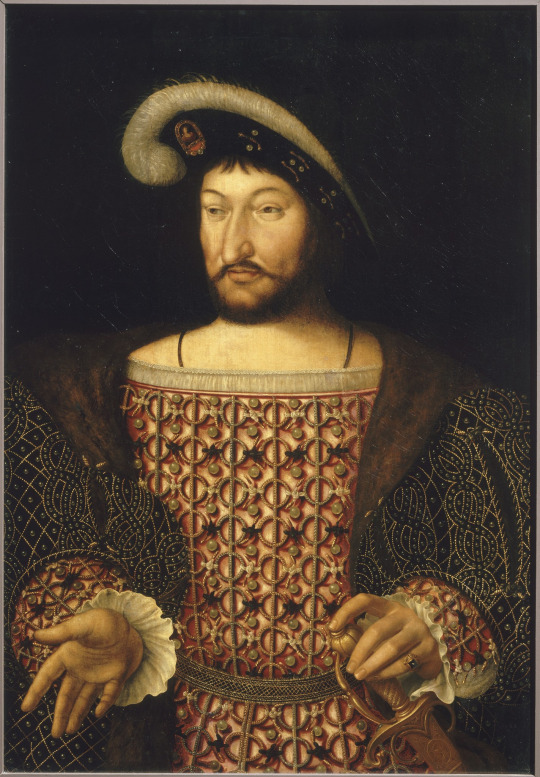
The Workshop of Joos Van Cleve (1480 or 1490 (ca.) – 1540 or 1541) • Oil on wood applied to the canvas • Château de Fontainebleau, Gallery of Splendours.
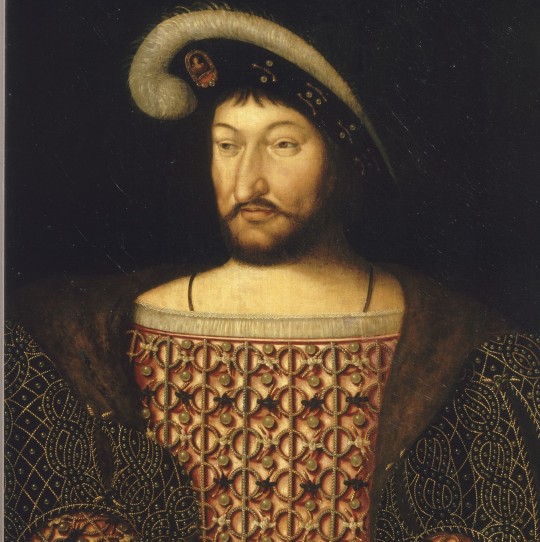
François I (Detail)
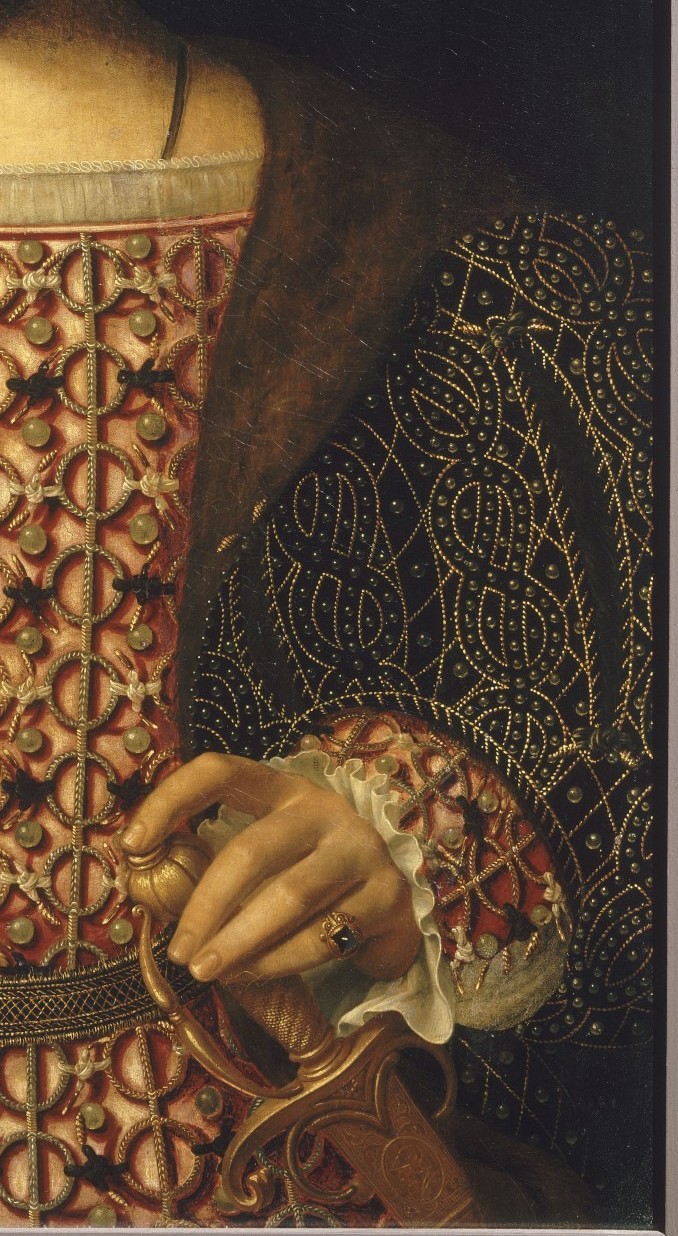
François I (Detail)
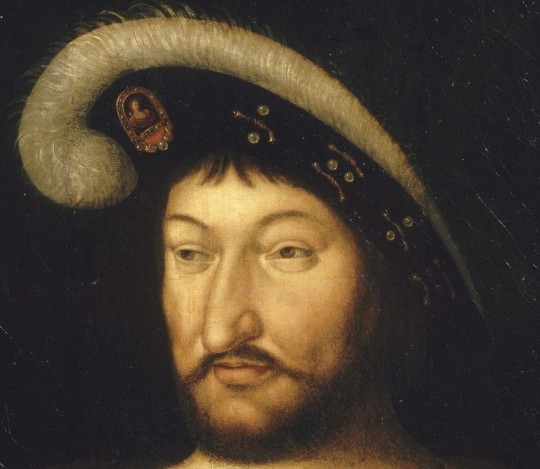
Besides being exquisitely dressed, and perhaps more importantly, Francis I was a great patron of Renaissance architecture and art. During his reign, he built or rebuilt numerous châteaus, including the Louvre in Paris and the magnificent royal residence at Fontainebleau. The king invited the Italian master Leonardo da Vinci to settle in France, and the artist spent his last years there. Francis also collected art works by Renaissance masters such as Raphael, Michelangelo, Titian, and Benvenuto Cellini. His collection of art, including a famous portrait of the king by Titian, became the core of the Louvre museum.
#portrait#art#painting#royal portraits#court portraits#françois I#french king#da vinci#jean clouet#french renaissance#art history#historical portrait#the resplendent outfit#tudor history#fashion history#royal fashion#17th century portraits#history of fashion#fontainebleau#musée du louvre
21 notes
·
View notes
Note
Granted the answer might be this was flimsy excuse, but if the official legal position was that Anne of Cleves' marriage to King Henry VIII was annulled over her already being married to Francis I, Duke of Lorraine, why wasn't she send from England to Lorraine to her true husband?
To put it quite frankly, because the idea that Anne was actually still betrothed to Francis of Lorraine was not a matter of objective fact but a tool of imperative royal need. The betrothal, which had been agreed upon back in 1527, had required the Duke of Cleves to pay a dowry to the family of the would-be groom. With Duke John unwilling or unable to make these payments, in 1535 the ambassador of Charles, Duke of Guelders (the great-uncle of Francis of Lorraine) informed Duke John that the betrothal was terminated for his failure to pay the agreed-upon sums. Too, when the marriage between Anne and Henry was agreed upon, the treaty documentation amusingly referred to as the "Beer Pot Documents" (for their inclusion of a beer stein image) were imperially notarized, recognized by the Holy Roman Emperor's own notary and treated as valid throughout the Holy Roman Emperor. If no less a figure than the Holy Roman Emperor was willing to treat as a matter of law the fact that Anne was free to marry Henry, then it would be really difficult to assert that Anne was in fact actually the betrothed or wife of Francis of Lorraine. It is also worth noting that Charles V considered the betrothal between Anne and Francis of Lorraine sufficiently non-existent that he married his own niece, Christina of Denmark, to Francis of Lorraine in 1541. Likewise, when Duke William gave his final response to Henry on the annulment in August 1540, he himself asserted that to his knowledge, there had never been any marriage or similarly binding betrothal between Anne and Francis. While it was convenient for the English court to assert than Anne was unable to marry Henry because she was actually the wife of Francis of Lorraine, the point of the assertion was to aid the king in removing himself from a politically troublesome alliance rather than to return Francis of Lorraine's supposed wife to him.
(This is putting aside the fact that neither King Henry nor Duke William was particularly interested in undertaking the considerable task of transporting Anne back to Cleves, much less anywhere else, following her annulment, no less because tensions were extremely high to the point of eventual war at this time between the Holy Roman Emperor and Duke William.)
(If you want more reading on the subject, I recommend Heather Darsie's Anna, Duchess of Cleves: The King's 'Beloved Sister, as well as her recent release, Children of the House of Cleves.)
41 notes
·
View notes
Note
Hope this works : https://i.pinimg.com/564x/40/e6/eb/40e6eb52d24dee59e597ca00f46bcddd.jpg
Original ask:People keep saying this is Frances Brandon, but looking at the fashion and the features of the sitter, I feel it's Katherine of Aragon instead. What are your thoughts?
(we didnt have the photo originally, but now i can finally answer this).
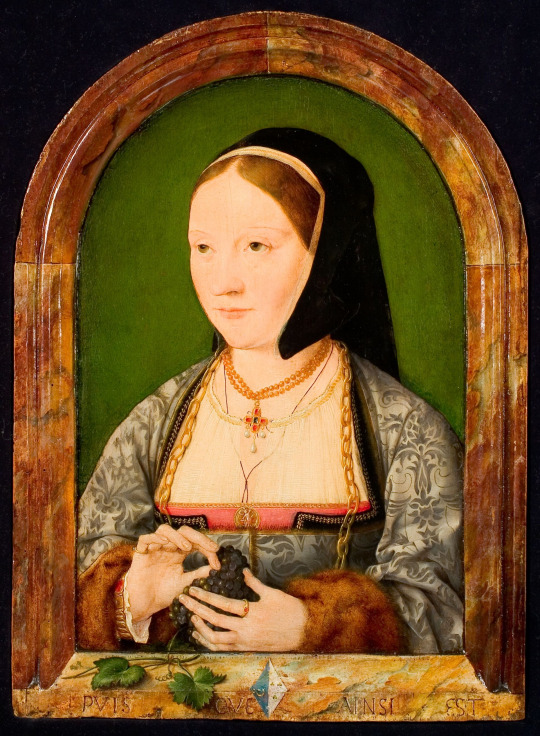
-My first observation regarding this painting is that it cannot be Francis Brandon, because she was born in 1517. This is 1500s or 1510s fashion of Netherlands. No way she could be depicted in fashion which is from before she was even born!
On wikipedia it is labelled Portrait of Agniete van den Rijne, atributed to Joos van Cleve, located in Rijksmuseum Twenthe in Enschede, in Netherlands. And as being painted in 1st half of 16th century.
On webpage of the museum, it is labelled as Unknown woman in c.1515. I suspect it could be bit earlier(split gown, large hanging chains)-my guess would be late 1500s, max early 1510s. But my chronology of netherlandish fashion was based upon court fashion. And neckline this low is consistent with some parts of Habsburg Netherlands, but not the court. So I could be bit off. But either way-1500s or 1510s imo. Not Francis Brandon. She wasnt even born when this was in fashion.
As for Catherine of Aragon.
Not that she couldnt wear netherlandish fashion(Sittow's portrait)-but a)when she did wear it, it was same fashion as in court.
b) what cut photos deliberately left out, is that this painting has its original frame...which includes coat of arms.

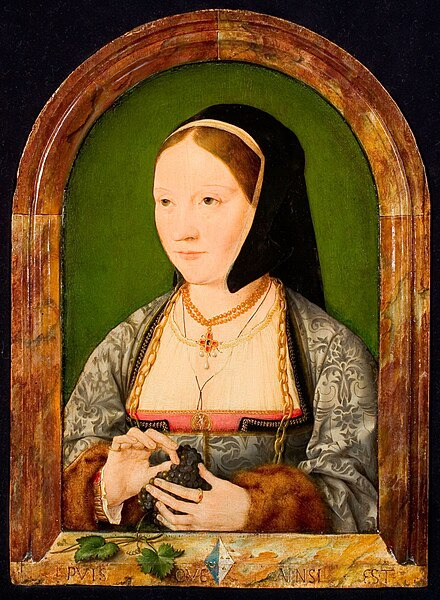
And experts believe this coat of arms to be original.

They havent been able to identify it nor of the man matching the woman. But clearly not Catherine's coat of arms.
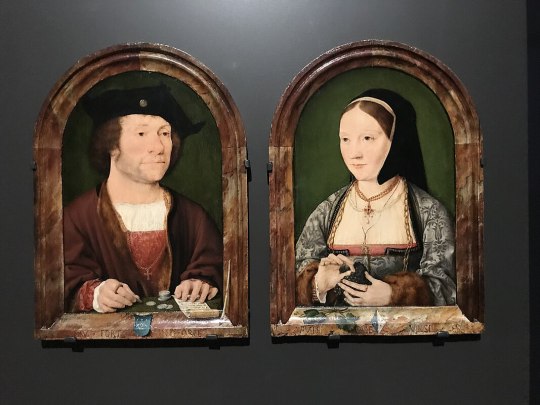
Also the focus here is on grapes-its fruit, its leaves and vines.
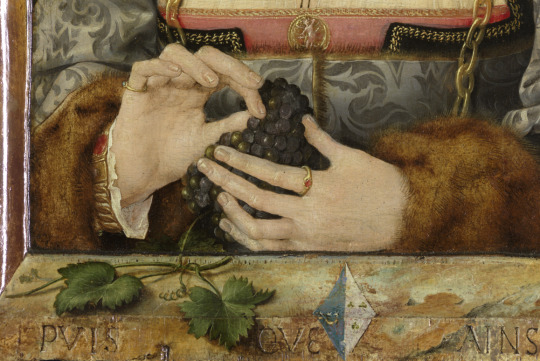
It is symbol of fertility and prosperity, as well as having several more meanings in christianity, but as far as i know never asociated with Catherine of Aragon specifically. And there is literally nothing to suggest it is her.
I agree that there is resemblence, but there is issue. The artist was skilled. So why upon closer inspection the nose looks so differently than hers?
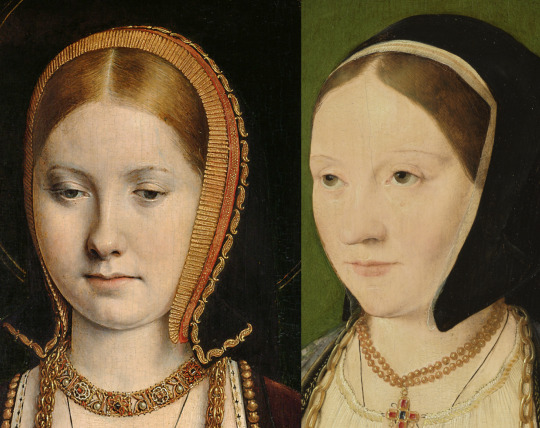
Catherine's nose tip seemed to be pointing more up and it was not as large. With some people-for example Margaret of Austria, size of nose changes as they age(due to health issues). However Catherine even in mid 1520s, still has narrow nose with tip basically same as in her youth.

Angle might play part a bit...but imo it is simply different nose.
The resemblence alone cannot drive identification. Not only do we not have single major clue pointing towards Catherine, we have major clue against her(coat of arms). Also Henry was likely painted by the artist when he met Francis I at Calais-with Anne Boleyn. The artist was asociated a lot with Francis, but never proven to travel to England or to take comissions from English royal court...aside that one meeting.
I am sorry, it is not Catherine of Aragon.
I am as upset as you guys that we don't have any surviving portrait of her from 1510s, and that many portraits we only know from not so great copies.
To find more lost originals, looking through art of artists which painted relatives of the person is indeed very good strategy. It pays off in many cases. Unfortuntely not in case of Joos van Cleve.
But it might be good idea to look up painters employed by Charles V and by Francis I in 1520-because Catherine met both that year.
Henry and Charles even had joined portraits made back then.
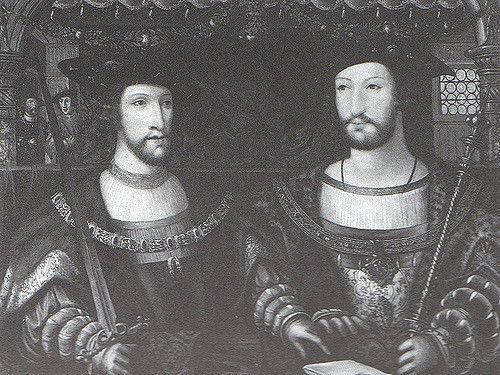
So there is indeed potential that some portrait of Catherine was created and it might have went with visitor. And it could have been another joined portrait because Charles didnt visit alone but with Germaine of Foix.
Problem is, the most likely thing for Catherine to wear in any portrait as Queen of England is gable hood- headwear unique to England. For her portraits to not be noticed, they would either have to be overpainted/altered, misidentified, misdated or even all three.
Another option is that upon meeting Charles that she wore spanish fashion. If she got painted in that, she wouldnt be that likely to be recognized.
Or maybe we need to broaden our idea of what Catherine wore.
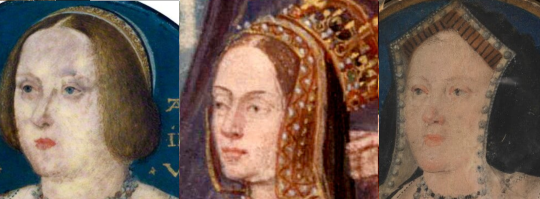
So my dears, the hunt is still on.
8 notes
·
View notes
Text
Katheryn Howard
Katheryn Howard, the fifth wife of King Henry VIII, remains one of the most tragic figures in Tudor history. Born around 1523 in Lambeth to Lord Edmund Howard and Joyce Culpeper, Katheryn's early life was marked by the complexities and struggles of her noble but impoverished family. Her father, a son of the 2nd Duke of Norfolk, and her mother, with previous children from a previous marriage, navigated a challenging aristocratic landscape. Katheryn's early years were tainted by relationships that would later haunt her. Her relationship with the music tutor Henry Manox during her time under the Dowager Duchess's care caused the duchess herself to intervene. Subsequently, she engaged in a consummated affair with Francis Dereham, a member of her uncle's household, before catching the eye of King Henry VIII. Her marriage to the ageing monarch in 1540, immediately following the annulment of his union with Anne of Cleves, led to Katheryn being in a position of prominence. Described as Henry's "rose without a thorn," she faced hostility from courtiers, given her past indiscretions. The Howard family's rise to power through her union only fueled resentment. However, Katheryn's most significant misstep came in the form of her relationship with Thomas Culpeper, a favourite of the king. Despite her previous entanglements, Katheryn's connection with Culpeper during her brief marriage to Henry was perceived as treasonous. The Archbishop of Canterbury, Thomas Cranmer, brought her premarital liaisons to light, leading to her confession and subsequent condemnation. On February 13, 1542, Katheryn Howard faced execution at the Tower of London. Despite her youth—some speculate she was only 18—she approached her fate with dignity. Five centuries later, her innocence is debated and it is often speculated if her tale was of tragedy or temptation.
A letter from Katheryn to Thomas Culpepper https://www.thirteen.org/wnet/sixwives/inherwords/ch_words.html
Catherine, according to French ambassador Charles de Marillac, was "a young lady of extraordinary beauty" and of "superlative grace."
#history#women in history#the tudors#katherine howard#katheryn howard#catherine howard#tudor history#english history#16th century#tudors#tudor era
10 notes
·
View notes
Note
Headcanons for Anne of Cleves, Katherine Howard and Katherine Parr in OT3 and OT4 verse?
The one thing I know about Katherine Howard right now is that Henry Mannox and Francis Dereham both fall into a ditch or something + partly due to her relative remaining Queen she has a much much better upbringing and education.
Katherine Parr shows up briefly in the first version of the OT3 verse as a governess to Owen, Edmund and Pippa but I’m slowly expanding her role - I borrowed the idea of her marrying the Duke of Norfolk’s son from @eidetictelekinetic - Kate Parr comes to court to be Mary Tudors lady in waiting, because their mothers were friends and they do in fact also become friends here. In theory she was supposed to be betrothed to a much older man but falling for and marrying the Earl of Surrey trumped that.
Anne of Cleves is currently a big mystery - I was toying with the idea of her marrying someone in England but I genuinely do not know who it might be. I will work something out though.
For OT4 verse:
Katherine Howard getting to have a loving husband and wife. It’s actually not entirely impossible that in this world, she marries the son of Charles Brandon and Mary Rose Tudor.
Katherine Parr ending up with Dorothy Seymour instead of Thomas Seymour is in fact my dream now I have thought of it.
Anne of Cleves I genuinely have no idea what she is doing in OT4 verse.
6 notes
·
View notes
Text
During Henry's reign there were six principal occasions of estate: his coronation in 1509, the meeting with Francis I at the Field of Cloth of Gold in 1520, the visit of Charles V in 1522, the meeting with Francis in Calais in 1532, Anne Boleyn's coronation in 1533 and the reception of Anne of Cleves in 1540. These were very much the exception; most occasions of estate were far less glamorous, such as the creation of peers, reception of ambassadors and the courtly ettiquette of births, deaths, and marriages.
The Royal Palaces of Tudor England, Simon Thurley
20 notes
·
View notes
Text
Six the Musical AU/Animatic
edit: these are so bad what was i thinking
- Dream as King George VIII
- Controlling, ruler, anger issues
- Sapnap as Catherine of Aragon
- Knew him the longest, loyal asf
- George as Anne Boleyn
- Brats, Dream clings like George to Anne (George can’t see green tho,, lol)
- Fundy as Jane Seymour
- Literally married, the one who gave him a son
- Technoblade as Anna of Cleves
- Unconventional, equals in terms of power and status
- Bad as Katherine Howard
- Easily manipulated, _ as Henry Mannox, a6d as Francis Dereham, Skeppy as Thomas the courtier
- Wilbur as Catherine Parr
- Musicians, logical
#dream smp#dsmp#mcyt#dream dsmp#sapnap#georgenotfound#fundy dsmp#technoblade#badboyhalo#wilbur dsmp#six the musical
10 notes
·
View notes